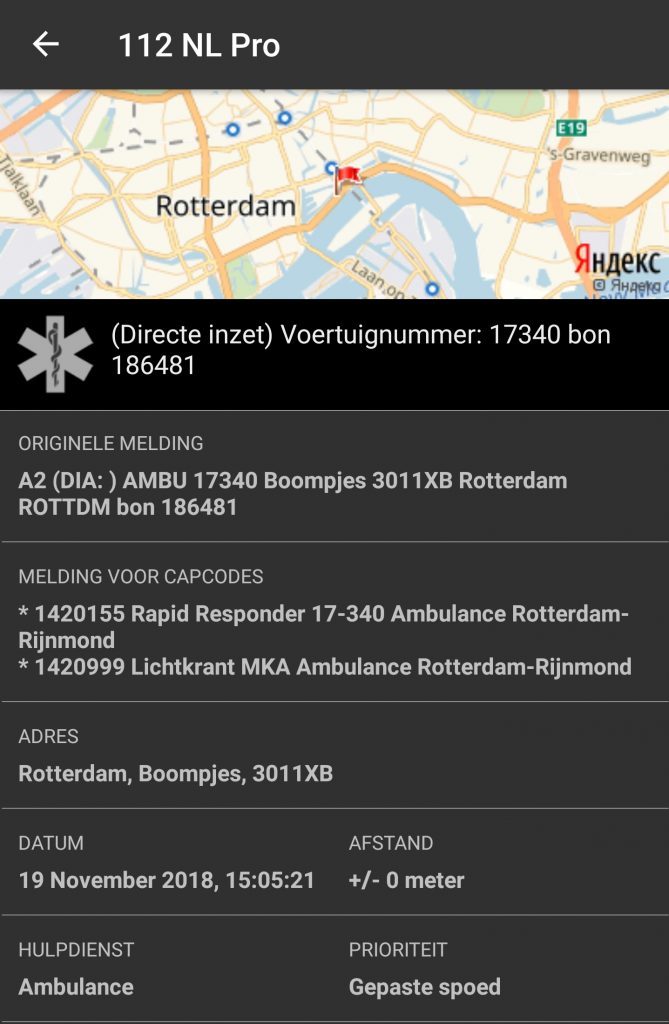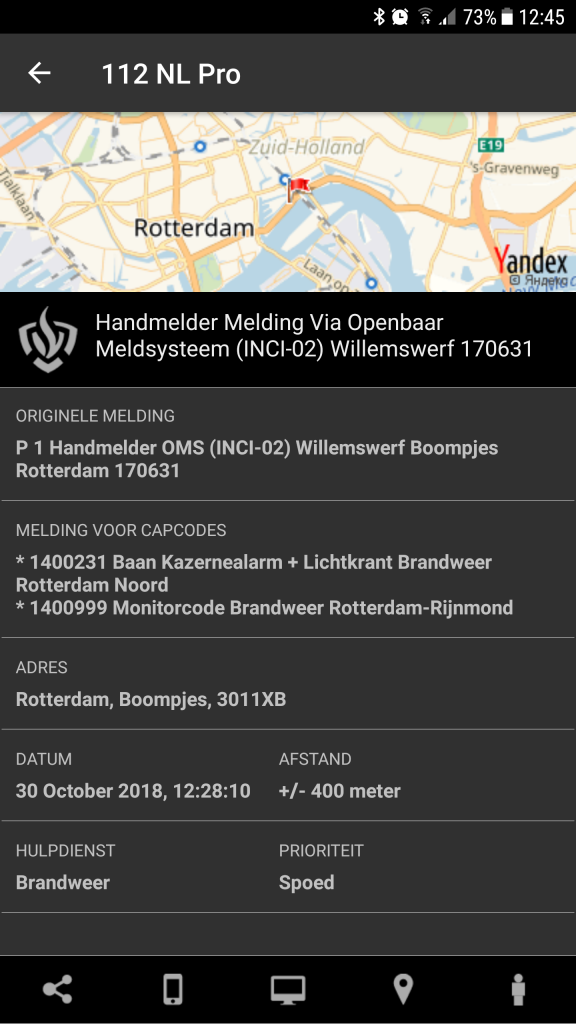Within Netherlands each company is by law required to have first responders. These handle various situations until the professionals arrive. It’s usually one of (possible) fire, medical or an evacuation. Normally I’d post this at Google+ but as that’s gone I’m putting the details on this blog. I prefer writing it down so later on I still can read the details.
November 6: P2000 warning
Within Netherlands any ambulance/fire department call is sent via the P2000 system. There’s various sites and apps which make that information easily available. I have one of these apps on my phone.
I noticed a Ambulance P2000 message for our postal code. The postal code could either be our building, or the one under construction next door. Until a few years ago P2000 would give the exact address, but due to privacy reasons nowadays it’s only the postal code. I ask security if there’s something. They’re not aware but they’ll monitor more closely (possibly ask around, e.g. reception might be aware).
A bit later security sees an ambulance arriving for the building under construction. The ambulance has difficulty getting to the right location due, for a while security was still under the impression it might be for our building. The building next door had various vans and construction stuff incorrectly being placed on the road. Things they should not have there, though they could’ve and should’ve cleared this while waiting for the ambulance to arrive.
November 11: Fire alarm
In the morning security had a talk with the construction crews next door about all the vans and so on blocking the road. Reoccurring problem mere days after their ambulance incident. This time they blocked way more of the road. Even the place near the goods elevator was blocked (registered fire department arrival location, plus where we direct all ambulances towards).
At 13:23 an automatic fire alarm for our building. Various people respond via walkie talkie. The location normally would require walking (running) up 7 floors; unfortunately this time I was on 6th floor. Arriving on the floor various indicator lights are indeed on, plus I meet various other first responders, plus security (who happened to be near the affected floor). We’re 4 in total.
The fire detector is located in a shaft. Opening this up requires special keys. Interestingly enough 3 out of the 4 responders are the ones who carry such keys. We open the shaft after doing a door check. The detector is one which detects smoke (security advised this); so it’s not the usual temperature sensitive one. The shaft itself is very warm, but there’s also some heating equipment in there. The heat combined with a detector which only responds to smoke gives us a suspicion that the heat is not indicative of anything. Despite that, there’s no indication of a reason for the detector to go off.
Two (me + another) are sent to investigate lower floors. We check one floor lower. Again we follow door procedure, accidentally open the wrong shaft, then the right one, nothing aside from heat. We try again another floor down, shaft is way cooler but nothing can be found. After communicating the latest finding we’re asked to regroup. After regrouping we decide to investigate the floor above.
On the floor above we notice some renovation going on (security is aware). But also an opened elevator shaft and some running equipment near that shaft. Opened shafts are very dangerous, it would allow any fire to easily spread within the building. This happened to a building 300m from our location.
As first responders this is the end of it. It was a fun exercise. Security however is not amused (understatement). Due to various rules no evacuation sound went off. Due to the fire detector being in a shaft any additional detector would’ve resulted in the automatic and legally unstoppable evacuation of the entire building.
As common in pretty much any bigger building, the fire detectors are linked to the fire department. After the detector went off the fire department call centre allowed us to investigate. There was some communication mishap in that call centre. While we were investigating the fire department crew showed up, lights and everything. This was quite visible for the next doors construction crew.. the ones who keep blocking the road. This was entirely unexpected, so it took a bit of time to talk to the fire department crew. The crew was however more than happy to wait for our investigation to be finished.
Iffy emergency exit doors
In case of a fire people are supposed to use the emergency stair cases. If you open any of such doors anywhere in the building security is immediately notified. This is for safety reasons; maybe something is wrong, there’s a real evacuation going on and it’s not something caught by the fire detectors or a call to security.
These emergency doors can also automatically unlock. Due to age, all over the building these doors are now automatically unlocking often. Leading to all kinds of false positives for security. A bit like a testcase failing because the hardware running the testcase is faulty.
I get asked a few times to manually close a few doors. A few times I notice. Many other times I do not notice the walkie talkie communication, nor my office phone or mobile being called. Oops.
I’m wondering if I can make calls from numbers to always be noisy. I often use vibrate/silent mode instead of e.g. do not disturb.
Eventually the problem is mostly fixed. It required the right company coming down various times.


